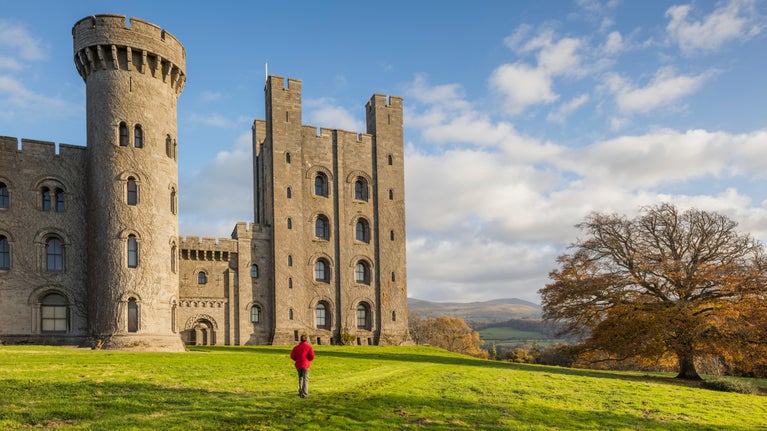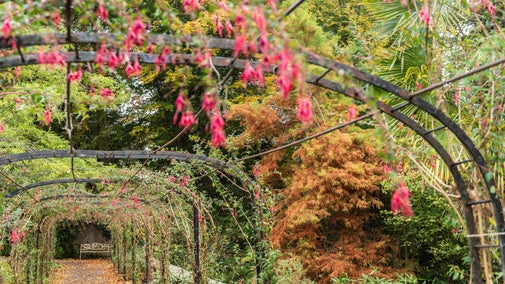
Penrhyn Castle and Garden's collections
Explore the objects and works of art we care for at Penrhyn Castle and Garden on the National Trust Collections website.

Penrhyn Castle is the former home of the Pennant family. It was rebuilt between 1820 and 1837 for George Hay Dawkins Pennant on the proceeds of the North Wales slate industry and sugar plantations in Jamaica. Take a deeper look at the background of this neo-Norman castle and the family that owned it.
The Pennant family had owned Jamaican sugar plantations since the middle of the seventeenth century. By the 1730s, they had moved back to England, becoming established as merchants in Liverpool and London, while still benefitting as absentee landlords from the profits of their Jamaican estates – and the hundreds of enslaved African people working for them.
Richard Pennant (1737–1808), MP for Liverpool, and the first Baron Penrhyn, established Penrhyn Castle as the family seat. He campaigned against the abolition of slavery and invested the Jamaican profits in his Caernarfonshire agricultural estates and the Penrhyn Slate Quarry. He built Port Penrhyn, as well as roads, railways, schools, hotels, workers’ houses, churches and farms.
When Richard died the estate passed to his cousin, George Hay Dawkins Pennant (1764–1840). As a Member of Parliament, for Newark in Nottinghamshire and New Romney in Kent, he consistently opposed the emancipation of enslaved people within the British Empire and when slavery was finally abolished, Dawkins Pennant received £14,683 compensation for 764 enslaved people on his Jamaican estates: Pennant’s, Denbigh, Cote’s and Kupuis.
The castle was built by the famous architect Thomas Hopper. Known for his ability to turn his hand to almost any architectural style, Hopper opted for a neo-Norman design – tried elsewhere at Gosford, County Armagh, but perfected at Penrhyn.
Hopper's hands-on approach also meant he oversaw the designing and making of furniture, carpets and decorative objects for the castle, all in the same extravagant and playful neo-Norman style. Featuring fantastical beasts, faces and patterns, the furnishings drew on the skills of local craftsmen, with furniture created in oak, ebony, marble and even in slate from Penrhyn quarry.
In 1840, with the castle finished, George Hay Dawkins Pennant died. His daughter, Juliana, inherited Penrhyn, and her husband, Edward Gordon Douglas, adopted the name Pennant and later became the 1st Lord Penrhyn of Llandegai.
A few powerful and wealthy landowners such as Lord Penrhyn developed small local quarries into a global industry. In some cases, this wealth was generated on sugar plantations worked by enslaved African people in the Caribbean.
As the Industrial Revolution gathered pace, propelled by the profits of enslavement and colonialism, demand for slate surged. Cities around the world grew and slate from the quarries in Gwynedd was widely used to roof workers’ homes, public buildings, places of worship and factories across the world.
Before he died, George Hay Dawkins Pennant expressly desired that a good collection of paintings be made at Penrhyn and charged his son-in-law (Edward, the new Lord Penrhyn) with the task.
Edward amassed an outstanding collection of Dutch, Venetian and Spanish paintings with the help of Belgian art advisor, C.J. Nieuwenhuys. Great names included Canaletto, Rembrandt, Wouwermans, Ruijsdael, Belotto and Palma Vecchio. Many of these pictures can still be seen in the Castle and the collection gave Penrhyn its reputation of being ‘the Gallery of North Wales’ at that time.

Another notable feature of Penrhyn’s interiors is the exquisitely painted Chinese wallpapers, hung in the 1830s. The sumptuous wallpapers are complemented by lacquer and japanned furniture and ceramics made in China and Japan, as well as Sri-Lankan carved ebony furniture.
In the early 20th century, relations between Penrhyn and local communities began to deteriorate. Exploitation of the workers in the quarry led to the longest running industrial dispute in Britain’s history.
Beginning in 1900 the dispute focused on Union rights, pay and working conditions. The Great Strike was a bitter battle between Lord Penrhyn and the quarry workers, the effects of which are still felt today.
In 1949, after the death of the fourth Lord Penrhyn, the land and title separated. The title went to Frank Douglas Pennant, who became fifth Lord Penrhyn, and the land went to the fourth Lord’s niece, Lady Janet Harper.
Two years later, Penrhyn Castle, along with the Ysbyty Ifan and Carneddau estates, came under the care of the National Trust.
Our research is ongoing and we are accelerating plans to reinterpret the stories of the painful and challenging histories attached to Penrhyn Castle. This will take time as we want to ensure that changes we make are sustained and underpinned by high quality research.
The Slate Landscape of Northwest Wales, including Penrhyn Castle, became the UK’s newest UNESCO World Heritage Site, having been granted the accolade in July 2021. The Castle plays a central role in the story of the area, and the National Trust will be working with partners across the World Heritage Site to explore the significance of the site further.
The landscape has become the UK’s 32nd UNESCO World Heritage Site and the 4th in Wales, following the Pontcysyllte Aqueduct, Blaenavon Industrial Landscape and the Castles and Town Walls of King Edward in Gwynedd.
The Slate Landscape of Northwest Wales, which runs through Gwynedd, became the world leader for the production and export of slate in the 1800s. Slate has been quarried in the area for over 1,800 years and had been used to build parts of the Roman fort in Segontium in Caernarfon and Edward I’s castle in Conwy.
- Mark Drakeford, Former First Minister of Wales (2018-2024)

Explore the objects and works of art we care for at Penrhyn Castle and Garden on the National Trust Collections website.
Learn more about the history of the Great Penrhyn Quarry Strike, 1900-03, the longest running industrial dispute in British history. Discover why it ripped apart a community.

Behind the formidable architecture, Victorian grandeur and fine interiors, present-day Penrhyn Castle’s foundations were built on a dark history of exploitation.

Penrhyn Castle is featured in the beautifully illustrated book, '60 Remarkable Buildings of the National Trust', written by one of our expert curators. Buy the book to learn more about five remarkable buildings in Wales, as well as other fascinating structures across England and Northern Ireland.

Penrhyn Castle's Stable block is currently closed whilst we develop a new experience arriving later in 2024. Find out what's happening here.

Penrhyn’s grounds and gardens are extensive and a feast for the senses. Find peace in the formal Walled Garden or explore the jungle-like Bog Garden.

The castle exterior hides an opulent and lavishly decorated interior. A much-loved home to the Pennant family, learn about some of the glorious rooms you can see on your visit.
